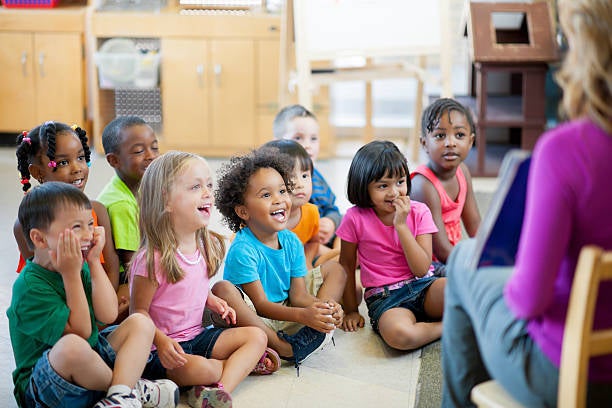This blog post was written by our wonderful postdoctoral fellow Andres Bustamante, me and Kathy Hirsh-Pasek.

It’s a sunny Tuesday morning and two very different preschool classes, both with caring teachers, are having a “lesson” in vocabulary.
Approach 1: [Children are sitting in circle time on the carpet around Ms. Mandy.] I want to teach you some new words today. The first word is “force.” Can you all say force? (Class responds – “force”). Force is when something is strong and can knock down something else. So what is force? (One child responds – “it’s strong”). Okay good! And what does it do when it hits something else? (Same child – “knocks it down”). Great job! Can you say the word again? (Class responds – “force”). The second word I want you to say is “ramp.” (Class responds – “ramp”)...
Approach 2: [Small groups of children are playing with blocks, ramps, and marbles that Ms. Ann intentionally left on the carpet]. Hi guys! What are you doing over here? (Child responds excitedly – “playing blocks!”). Wow! That sounds fun! I see you are rolling the marbles down the ramp! (Child responds – “Ya it’s fast!”) It sure is fast! Hey, what do you think would happen if you put a block at the bottom of the ramp? (Child – “it would block it”). You think so? Why don’t we try it! [Child gets a block and places it at the end of the ramp then rolls a marble from the top and the marble knocks the block over]. Whoa! Look at that! What happened? (Child response – “it knocked it down!”) That’s right the force of the marble knocked down the block when it rolled down the ramp! When things are going fast, they gain force and that lets them knock other things over! Do you think the marble has enough force to knock down two blocks if we roll it down the ramp? [Ms. Ann and the children proceed to test how many blocks the marble can knock down. They also change the slope of the ramp to vary the speed of the marble and discuss how the ramp changes the marble’s force.]
This second approach is our vision for the 21st century preschool — a place where playful engagement meets targeted learning. To many, preschool is a place where working parents drop their children so they can play – maybe, just maybe, learn the alphabet and some social skills -- under the watchful eye of a warm caregiver. The latest research, however, suggests that preschool needs to be so much more. A recent report from the Brookings Institute and a new study by Bruce Fuller and colleagues both tout the power of high quality preschool -- but also warn that to be truly high quality, preschool teachers must be deliberate about delivering basic academic and social-emotional skills. Educators must be thoughtful in setting up the experiences that impart basic skills if children are to be ready for formal schooling just one or two years later. Put plainly, if children are to learn math, language, literacy, and science -- they must be taught math, language, literacy, and science.
This alert from the science of learning could seem like a mandate to treat 3-, 4-, and 5-year olds more like 1st or 2nd graders. Should we line them up at desks in rows and make them sit still for hours and fill out worksheets? The authors of the Brookings report and Dr. Fuller are clear that this is not the path to success. The Brookings report states:
Preschool children benefit most from sequenced, explicit instruction focused on specific academic (e.g., literacy or math) or socioemotional (e.g., self-regulation or problem-solving) skills and provided in the context of play and exploration.
While Dr. Fuller suggests, “If you can combine creative play with rich language, formal conversations and math concepts, that’s more likely to yield the cognitive gains we observed.”
Research in the science of learning tells us that children learn best when they are actively engaged with meaningful material and working with peers. Children learn in a way that "sticks" when these factors are present, and have so much fun that they can’t wait to learn more. The second example above is what we call “guided play” which is a discovery-learning approach intermediate between didactic instruction and free play. During guided play, children are engaged in hands-on activities and the teacher serves as an encouraging partner who builds on children’s interests to teach new content and skills – and capitalizes on learning moments as they arise.
Could children learn the words on their own if they played without the teacher? Not likely. Our research complements that of Fuller’s suggesting that playing alongside a caring adult who has a curricular goal in mind is really important for learning. Neither end of the spectrum between “free play” (just kids) and drill (as in Example 1) will foster the requisite skills for children. Guided play is the happy medium that maintains the joy and excitement of playful discovery while still aimed at imparting key academic skills and social-emotional understandings such as the ability to regulate your emotions in the face of frustration and to cooperate with others. Enhancing the learning environment in a fun, yet rigorous way also brings the additional payoff of helping children learn the broader learning-to-learn skills like grit and perseverance.
Can a preschool be both high quality and fun? You bet. Let’s use the science as our base and move towards a model with targeted academic curricula that are delivered in a playful pedagogy. It is time for preschool 2.0.